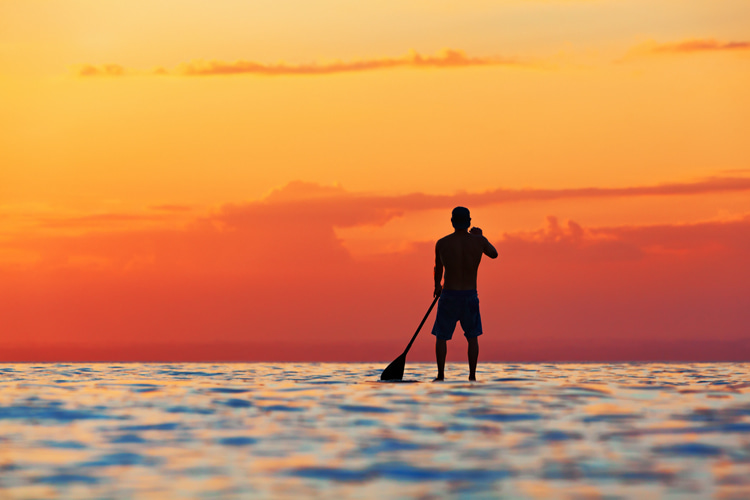One of the attractions of stand-up paddleboarding (SUP), especially for anyone new to water sports, is its simplicity and accessibility.
However, whenever we are near or on a body of water, there are risks and challenges to think about.
This is not just for our own safety and enjoyment but for the safety of other water users around us and the emergency services that would need to rescue us if something goes wrong.
In this section, we will go through a few ideas to think about when you get started with SUP and give you more specialized information to build up your knowledge and skills and ultimately make paddleboarding even more fun.
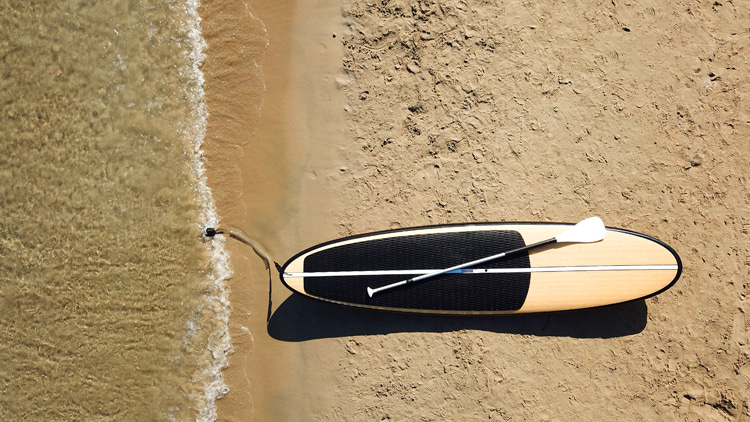
The Basics
For those new to SUP, there can be a lot to take in. Here is a list of some of the equipment you will encounter:
Inflatable Board
Inflatable boards are ones that you pump up yourself by hand or using an electric pump.
When not in use, they are deflated, rolled up, and packed away for transport and storage.
They usually come as a package with a bag, paddle, and a pump to inflate them and are also known as iSUPs.
Hardboard
Also known as rigid or solid boards, hardboards are usually made of fiberglass and epoxy resin wrapped around a foam core.
They can be made in shapes and sizes more suited to specialist SUP disciplines such as racing or surfing.
They do not fold down, and you do not need to inflate them.
Paddle
The paddle is like a handheld oar that you use to move through the water.
It has a handle, shaft, and blade - the blade is the part that goes into the water.
Leash
The leash attaches you to your board and can be worn around your ankle, calf, or waist.
Your board is a good buoyancy aid, and wearing a leash means you won't be separated from it should you fall in.
For recreational paddles, such as the ones shared in this guide, a coiled leash is recommended.
SUP surfers would wear a straight leash. It is important to keep up to date with leash advice.
Buoyancy Aid
The buoyancy aid is a piece of equipment that will keep a conscious person who is able to keep their head above water afloat.
It is also known as a personal flotation device (PFD).
Fin
Fins are attached to the back (tail) of your board to help with control, direction, and balance.
The number and size of the fins (for example, a center fin and two side fins) on a board can vary according to the make and type of board, as well as what sort of paddling you will be doing.
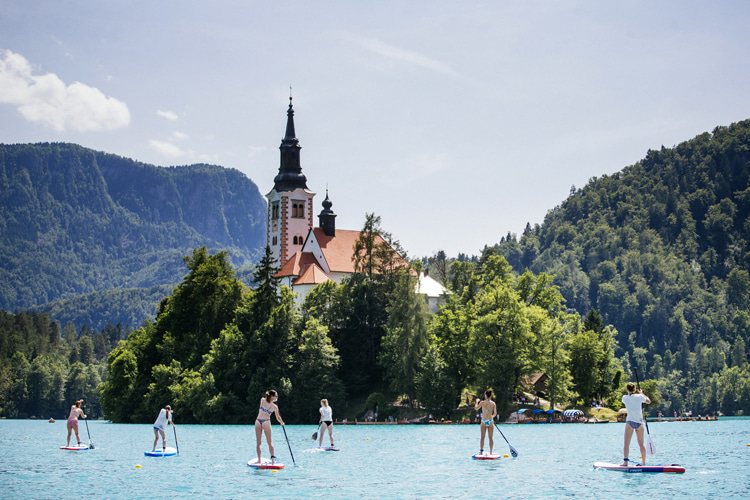
Choosing an Instructor
My number one top tip for anyone getting into SUP is to take a lesson or course of lessons with a qualified instructor.
They cover safety, skills, equipment, the environment, and confidence-building - everything from what to wear and how to set up your board to SUP strokes, turns, and stopping to what to do if you fall off and how to self-rescue.
Additionally, they might share knowledge of the local SUP spots.
A SUP school, club, or instructor may also run SUP socials where you'll meet other people from the paddleboarding community.
It's worth investing in some lessons if you've been paddling for a while but didn't have a chance to have a lesson at the outset.
A good instructor will be more than happy to review your technique and help you build up your skills and knowledge.
In addition to taking lessons with a qualified instructor, you could also consider online safety skills courses.
For example, the Water Skills Academy's (WSA) safety video tutorials and iSUP Smart online course, the SUPfm SUP Safety Course, and British Canoeing's Go Paddling website for SUP safety video tutorials.
Learning and improving your skills, knowledge, and understanding of the environments you'll paddle in will help make you safer and more confident in your ability to judge conditions every time you are on the water.
This, in turn, will make it much more fun.
Choosing a Qualified Instructor
Most instructors and schools will put their qualifications and accreditations on their websites or social media details.
If you don't see that information, feel free to ask.
Awarding bodies they may have trained with are the Academy of Surfing Instructors (ASI), British Canoeing (or a British Canoeing affiliated club), BSUPA, International Surfing Association (ISA), or WSA.
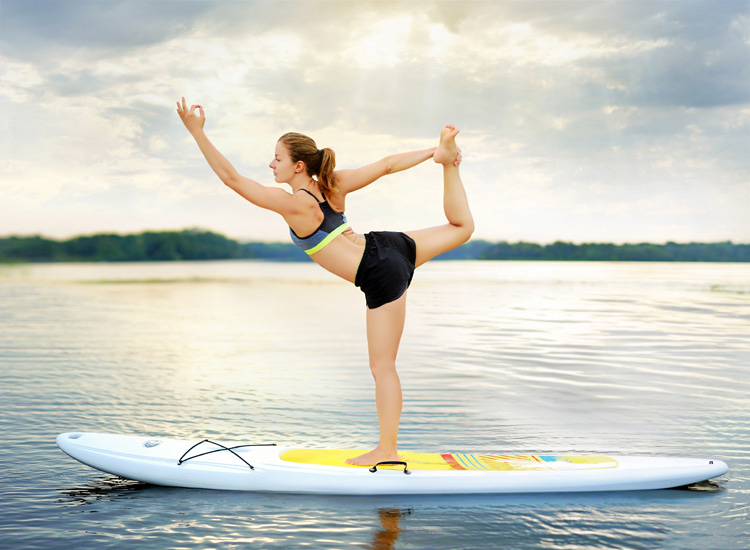
Licensing and Access
Paddling on Inland Waterways
If you're wondering whether you can paddle anywhere you want on inland waterways, the short answer is no.
There are over 68,000 kilometers of inland waterways in England and Wales.
Of that, approximately 2,250 kilometers can be paddled uncontested, which equates to four percent.
This is why British Canoeing is developing the Clear Access, Clear Waters campaign working for fair, shared, and sustainable open access to water for all.
As Ben Seal of British Canoeing explained to me, only a small percentage of waterways in England (and even fewer in Wales) have a Statutory Right of Navigation.
British Canoeing has been campaigning for a change in the law and supporting paddlers to be proactive in paddling responsibly, respecting the environment and other users, and demonstrating that they are guardians of our waters.
Licenses
In England and Wales, you need a license to paddleboard on inland waterways (such as river navigations and canals) managed by the Canal & River Trust and Environment Agency, plus others such as the Norfolk Broads.
You can buy a license from British Canoeing, Canoe Wales, the Canal & River Trust, the WSA, or directly from some navigation authorities.
When deciding where to buy your license, look at what and where is covered plus the benefits, for example, liability insurance included within the membership fee, and which is right for you.
In Scotland, you do not need a license to paddleboard due to the Land Reform (Scotland) Act 2003.
However, membership in the Scottish Canoe Association offers a number of benefits, including liability insurance.
Additional Charges
Some places, such as the Royal Military Canal and Liverpool's Royal Albert Dock, require an extra fee as well as a license.
Harbors may require a license from the Harbour Master's Office. Some lakes are private and charge a launch fee, so do check ahead.
Before you travel somewhere new, do your research so you have the right information and can explore with confidence.
Visit www.gopaddling.info to see which, if any, license is required.
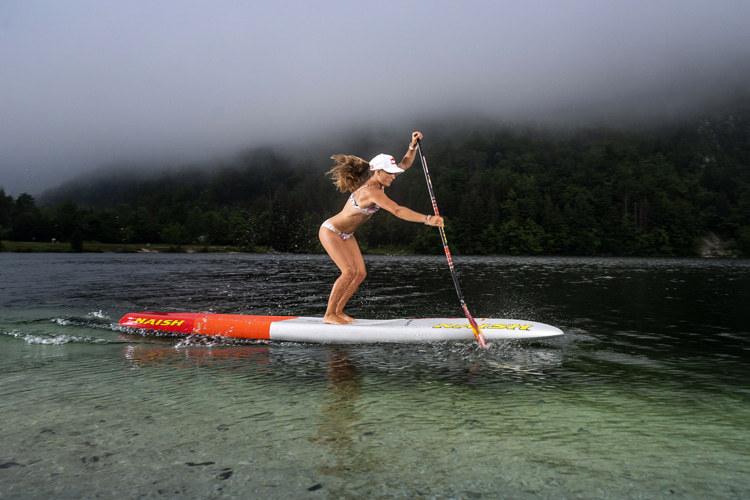
Choosing Your Equipment
Deciding on Your Board
Buying your own paddleboard is a big decision, both financially and as an investment in your well-being; you want to get it right.
I asked Sean and Claire Scott from The New Forest Paddle Sport Company for their advice:
Construction
Consider whether you want a hard or inflatable paddleboard.
Hardboards give a better paddling experience due to a shaped and more refined board, but they are heavier than most inflatables and are difficult to transport and store.
Inflatable boards are lightweight and robust and normally come as a package with pumps, paddles, and bags but are limited in performance paddling or trickier conditions due to board shaping.
Location
Consider what type of paddling you want to do and where.
There are lots of different boards designed for a range of activities, from SUP surfing, touring, and racing to SUP yoga.
Particular SUP Boards
Consider what you want your board to do.
If you are new to SUP and want a board that will do everything, an all-around-style board may suit you best.
Be aware, however, that these are slower and not maneuverable enough for large waves.
If you want to go on river paddling tours or day trips, a touring-designed board is longer and narrower for increased glide and efficiency over distance.
If you want to tour on a river or canal with lots of portaging (carrying) or do one-way trips, then inflatables are easier to carry and pack away.
For coastal paddling on day trips, hard touring boards will handle the chop and swell better than an inflatable.
Choosing a Paddle
It is important when buying packages to look at all the accessories and their quality, especially with paddles.
The best thing you can do is try out lots of different paddles and boards before purchasing your first board:
Material
The more expensive packages come with carbon paddles and high-quality pumps and bags which will last.
The cheaper packages tend to come with aluminum paddles which can corrode quickly in salt water, don't always float, and are heavy.
Shape
The shape of a paddle is very important as well as the size.
Standard blade shapes are the classic teardrop or the High Aspect shape, which is designed for racing and touring and will give you a more efficient paddle stroke.
I spoke with Claire Scott recently and learned that approximately 90 to 95 percent of new boards purchased at her shop are inflatable.
I use an inflatable board as I simply don't have the space at home to store a hardboard.
Almost everyone I paddled with researching the book used an inflatable too.
Coiled Leashes
A leash is a vital part of your safety equipment. If you fall in the water, the leash means your board will remain nearby.
Leashes can be straight (used in SUP surf) or coiled.
Most recreational SUP packages are currently supplied with a coiled leash, which is worn around your calf or ankle.
The leash sits on the deck (or top) of the board so that there is less chance it will snag on branches, ropes, moorings, or obstructions under the surface.
A coiled leash can also be used with a quick-release (QR) belt, which is worn around your waist.
The QR belt has a buckle and a pull cord or toggle.
It sits high out of the water and is less likely to snag on debris on moving water, as you find on estuaries or rivers.
You may find yourself in a situation where you need to separate yourself from your board, where there is a risk of entrapment on an obstruction.
A QR belt will allow you to free yourself by pulling the toggle at your waist rather than trying to reach down to your ankle, which could be difficult if the force of the water is pushing you down.
Some brands sell QR belts with their boards, but they are available to buy separately.
At the time of writing, a campaign is calling for manufacturers to supply them as standard. My preference is to wear a QR belt now.
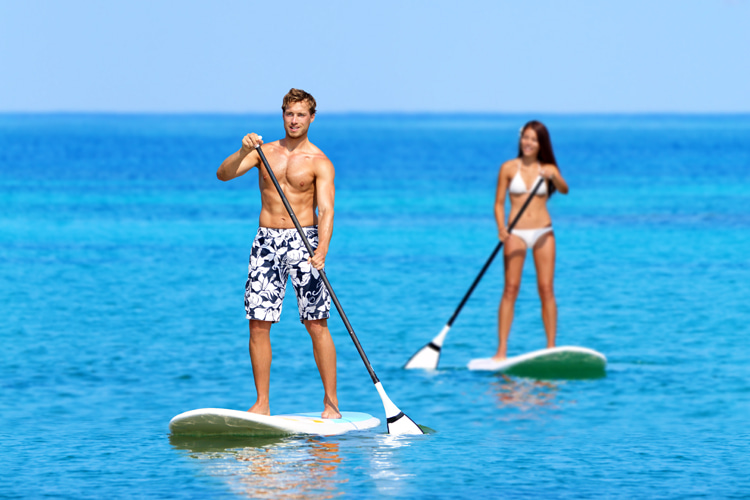
Handy Tips
Inflatable Boards
In hot weather, let some of the air out of your inflatable board and keep the board out of direct heat and sunlight.
Simply pump it up when you are about to go on the water.
Whether you use an electric pump or hand pump is a preference, and I personally enjoy the ritual of pumping up my board.
Do not be surprised that when you deflate an inflatable board, it can be very loud.
As a courtesy to people around me in a public place, I try and warn them that I am about to deflate.
Investing in an upgraded paddle will have a positive impact on your technique, endurance, and comfort.
Leashes
There is very specific advice for SUP surfing and white water SUP. It is important you follow the guidelines for these disciplines.
Have a lesson with a qualified instructor or coach, learn how to use a QR correctly, and practice on land.
Ensure that you fix your leash correctly and securely to your paddleboard each time you use it.
Regularly check your leash for decay and potential breakage.
Keep up to date with safety and equipment advice from platforms such as ASI, British Canoeing, BSUPA, ISA, WSA, Stand Up Paddle UK, RNLI, RLSS, and SUP Mag UK.
Words by Jo Moseley | Stand-Up Paddleboarder and Author of "Stand-Up Paddleboarding in Great Britain"
